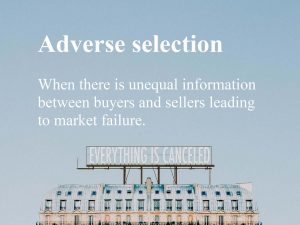
What Is Adverse Selection?
What Is Adverse Selection?
Adverse selection is a term that describes the presence of unequal information between buyers and sellers, distorting the market and creating conditions that can lead to an economic collapse. It develops when one party has more information than the other, creating difficulties in targeting clients. For example:
- When buyers of insurance have access to more information than brokers and insurance companies, they are more likely to file claims, leaving the sellers reluctant to issue policies.
- When resale stores have a better understanding of the value of their products than the buyers do, the buyers will be skeptical and fearful of being “ripped off” by the seller.
Adverse Selection in the Insurance Industry
People take out insurance policies based on perceived risk. For example, in the health insurance industry, the people most likely to voluntarily take out policies are those in poor health or at high risk of seeing their health decline in the coming years.
Healthy people are less likely to choose to get health insurance coverage. This is especially true when the rates they pay are inflated to account for the higher risk of insuring unhealthy individuals.
Other examples of adverse selection in the insurance industry include:
- Those at a higher risk of death in the coming years or decades being more likely to purchase a life insurance policy, causing companies offering average prices to lose money.
- Companies selling life insurance at a high price to account for higher-risk clients failing to appeal to younger and healthier people who might otherwise be interested in a policy as a just-in-case measure.
- People living in high-crime areas are more likely to take out renters insurance, but if the policy provider charges average costs, they might fail to make a profit.
The Negative Outcomes of Adverse Selection
- Companies that lack information may struggle to select customers and will be forced to charge higher prices to balance profit with risk.
- Customers that pose little risk will often fail to buy since the cost is disproportionate to their needs.
- Companies need to invest significant time and money into identifying low-risk demographics and targeting them.
- Sellers with better information may restrict sales to times when the climate is most favorable to them, such as issuing shares when they know the price is overvalued.
Correcting for Adverse Selection in the Insurance Industry
To account for adverse selection, insurance companies must use demographics to segment buyers and alter the premiums accordingly. This is why someone who smokes and has obstructive sleep apnea can expect to pay more for their health insurance than someone who has healthy habits and no sleep-breathing disorder. The greater the risk, the higher the premium.
In the United States, most people are insured through private health policies. For decades, this exasperated adverse selection since young and healthy people often skipped taking out a policy. In turn, this drove up premiums across the board, leaving even those who needed health insurance unable to afford coverage.
The Affordable Health Care Act aimed to correct this. Through the compulsory coverage element, it required that the majority of Americans take out a policy or face fees come tax time. The idea was to spread out the cost of insurance policies by bringing lower-risk individuals into the pool.
Ultimately, adverse selection will always be an economic force. It is up to each industry to establish policies and best practices to account for it.




